Japanese Madaké Bamboo for Shakuhachi
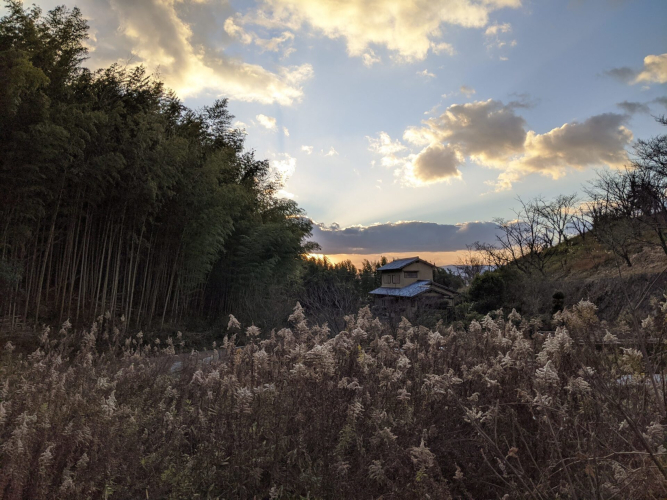
My favorite photo from my Madaké bamboo harvesting trip to Nara Japan, 2020 (you can read about it in my journal)
Videos of me harvesting Japanese Madaké Bamboo for Shakuhachi
The videos above show me harvesting Madaké Japanese bamboo (také hori ). They also show me processing the bamboo, including performing Aburanuki or "fire curing". Hours, days, or even weeks of labor was edited down to just minutes (no part of the 10 or so hours of root cleaning and trimming was filmed, for example).
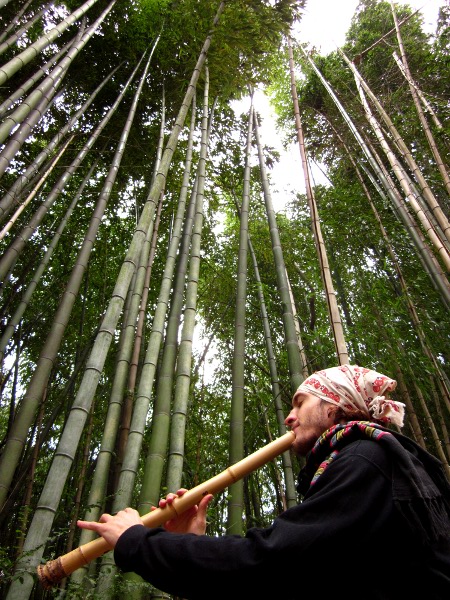
Playing shakuhachi in front of giant Madaké bamboo, 2010
Over the years, I’ve been in many Madaké bamboo groves, hunting for prime pieces with which to craft my shakuhachi. Entering and exploring each grove is to step outside of time and place. Immediately, you’re dwarfed by towering bamboo giants which stand as a testament to the resilience of life on earth. Potential shakuhachi are swaying in the breeze as living bamboo. Yet, because each stalk has a lifespan of at most around eight years, it also reminds us that all things are transient.
What also becomes apparent upon seeing living Madaké bamboo is that shakuhachi truly embodies it. For instance, the shakuhachi is held upright with the root facing down which shows us how bamboo grows out in nature. We, also being a part of nature, utilize the bamboo which, with no small amount of effort, provides us with shakuhachi. Before I wax poetic any more, come with me into the Madaké bamboo grove and let me tell you all about this wonderful grass; both how and why shakuhachi are crafted from it.
Madaké 真竹, Banzhu 斑竹, Phyllostachys bambusoides, "giant Japanese timber bamboo" - A rose by any other name
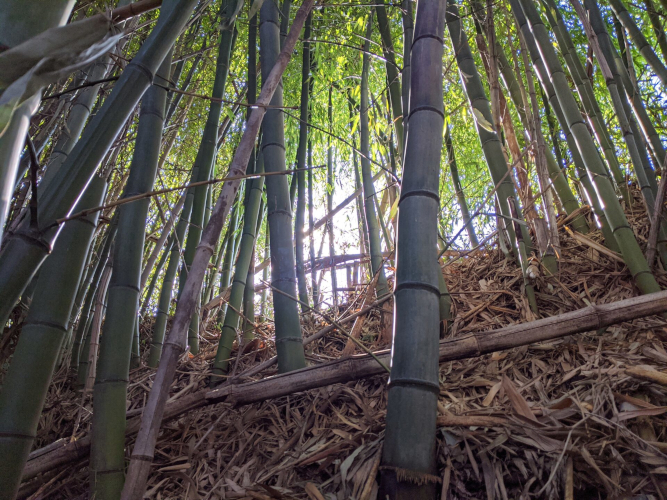
Inside a Madaké bamboo grove, taking a break from harvesting pieces for shakuhachi, Nara Japan, 2020
Madaké 真竹 is the primary bamboo used for crafting shakuhachi. Like many things Japanese, it originates from China, Zhejiang province to be exact. Madaké bamboo all over the world has the exact same DNA because it reproduces asexually directly from the roots or rhizomes. However, growing conditions such as the soil, lay of the land, exposure to sunlight, climate, and micro-climate, all have significant effects on how it grows. Regardless, the rhizomes snake and knit through the soil like subterranean dragons, at times bursting out of the ground only to dive back in again; always forging ahead, even if that means taking a few detours.
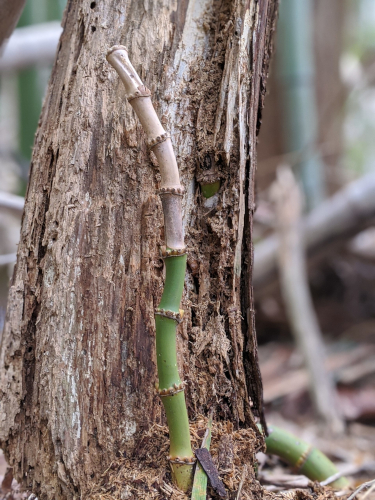
A rare sight, Madaké rhizomes growing up into a rotting log which deteriorated around them, Japan 2020
That being said, every one-hundred years Madaké all over the world also flowers at the exact same time, after which all of the stalks die. The last time this happened was in the 1960's and it devastated the Japanese craft world. Thankfully, the rhizomes, the "mother of the bamboo" survives this flowering. These subterranean wombs give birth to each stalk as a new shoot bud which soon breaches the earth, climbs toward heaven, and fans out their leaves like an umbrella in order to process light into life. The whole grove is one large family, tightly interconnected. When we harvest a piece from one part the whole grove knows it...

Me playing shakuhachi by visible Madaké bamboo rhizomes, 2010
It's amazing to see these new shoots telescope out to their full height, and nearly their full girth, within just a few months. With some shoots as big around as ones thigh, it can make one feel like a small insect. As we saw in the image of me further above, Madaké is indeed a "giant" bamboo; it wants to get big. When the growing conditions for it are ideal it will get as large as possible with few stalks at the correct size for shakuhachi. Over each growing season these new stalks put out new limbs and leaves but stop at about three to four years old.
Why only Madaké bamboo for shakuhachi?
Of course, the characteristics of Madaké bamboo and its abundance in Japan are why it’s the primary bamboo used for crafting shakuhachi. For example, it typically grows very straight with good distances between the nodes for finger-hole placement (internodal spacing). The lower portion that's used for crafting shakuhachi can also have a nice inner taper which is essential for the correct shakuhachi sound and feeling (more here in my essay The Shakuhachi and Traditional tapered shakuhachi bores vs. cylindrical bore flutes, such as pvc).
That being said, other sub-varieties of Madaké bamboo can work excellently for crafting shakuhachi as well. For instance, there’s a certain rare sub-variety of Madaké bamboo which, in all objective ways, tends to produce better sounding Jinashi shakuhachi than standard Madaké. It’s also possible to craft very fine shakuhachi from above root bamboo, which I do quite often (see About Murei shakuhachi).
Harvesting Madaké bamboo for crafting shakuhachi
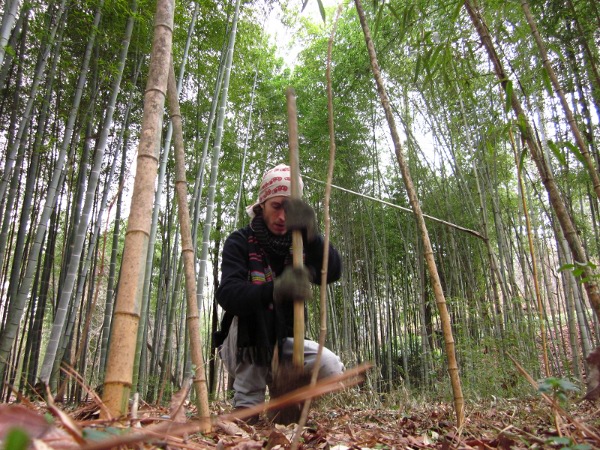
Me harvesting Madaké bamboo sub. var. 'Green stripe' for shakuhachi (note the giant Moso bamboo behind me), 2010
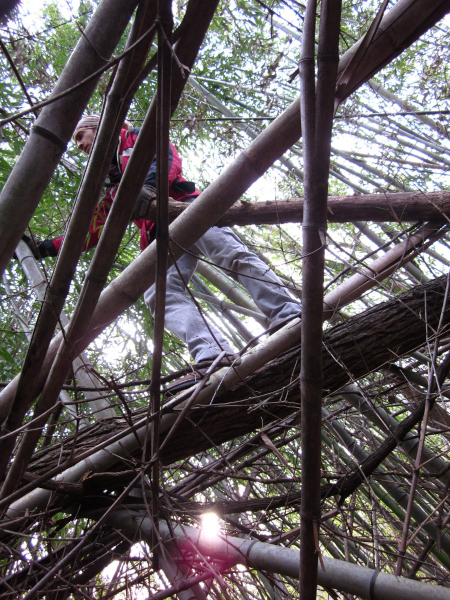
Precariously traversing a wild, unkempt Madaké bamboo grove in search for the perfect pieces for shakuhachi, 2010
I began harvesting my own bamboo to craft my flutes around 2001~2002 when I was about fifteen or sixteen years old. Back then, I lived between Florida and Norfolk Virginia, USA, both of which are teeming with amazing bamboo groves. Of course, I’ve also harvested Madaké bamboo in Japan. Every bamboo grove is totally unique, yet each one feels like home to me.
As many of you are aware, shakuhachi have been primarily crafted from root end Madaké bamboo since at least the 1700’s in Japan. Prior to that, the root end was not yet utilized (see Shakuhachi History for more). While shakuhachi can and have been crafted from above root bamboo, the bell-like root end stands as the unforgettable silhouette of the shakuhachi.
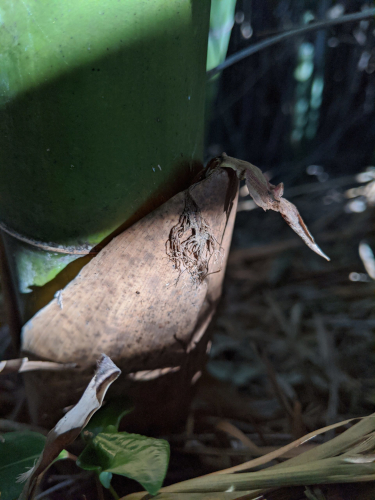
Spider-like Madaké auricle on a dried shoot sheath in Japan, 2020
However, before harvesting begins a positive ID must be made to determine if the bamboo in question is in fact Madaké (Vivax and Makino can look identical, for example). The only way this can be done is to find and examine a bamboo shoot. This is ideally done in Spring when they're budding, however, a dead shoot can also suffice for making a positive ID. Madaké shoots are smooth and waxy, leopard spotted, leaves at tip a bright pink, and possess vivid green spider-like “auricles” (Makino shoots look quite similar however they're darker and covered in coarse hairs).
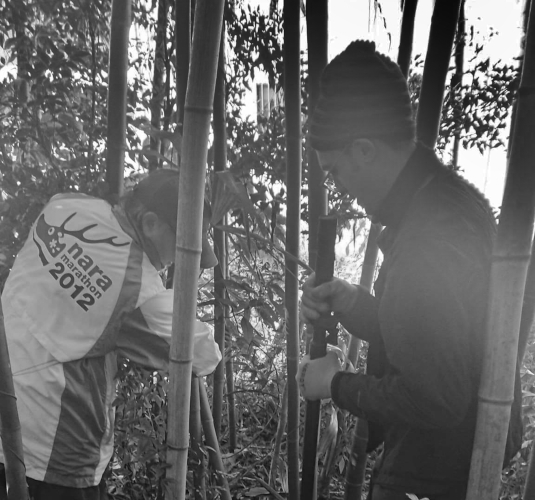
Digging out Madaké for shakuhachi with help from the land owner, Nara, Japan, 2020
Next, many hours are spent scouring the grove for suitable pieces for shakuhachi; I like to get a feel for the whole grove, when possible, before beginning to dig. After meticulously considering suitable pieces for shakuhachi many more hours are then spent digging them up. This is no easy task as, besides the roots of the stalk itself, each root-ball is connected to and wrapped-up in rhizomes. These rhizomes are solid and unbelievably hard and have shattered my tools on more than one occasion (near the end of one of my harvesting trips to Japan my "indestructible" "Slammer" tool shattered on a rhizome).
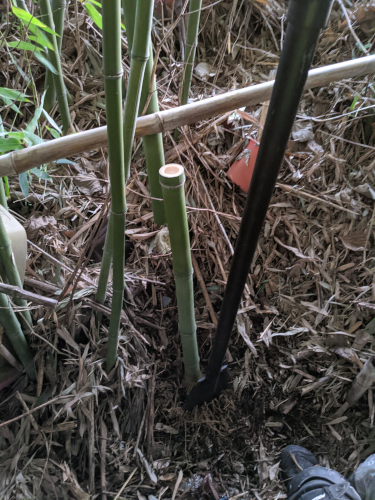
Digging out Madaké for shakuhachi with Slammer tool before it shattered, Nara, Japan, 2020
While it may at first seem somewhat cruel to rip living stalks of bamboo from the earth to craft our shakuhachi, it’s just like picking a vegetable. For shakuhachi, we also strive to only harvest old, dying, or dead stalks which serves to actually keep the bamboo grove as a whole more healthy (culling). Removing these stalks makes way for the new and prevents overcrowding which helps stave off infections and infestations.
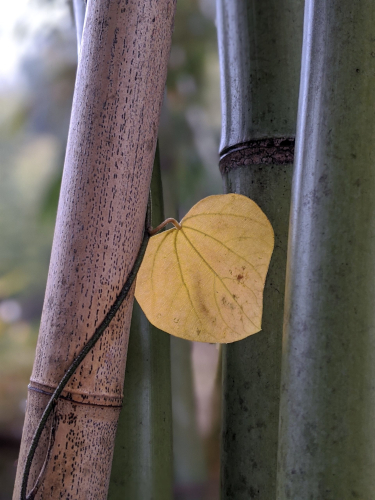
A dead piece of Madaké with prized goma spots, still in ground, vine growing up it, next to still living green stalks, Nara Japan, 2020
As mentioned previously, the average lifespan of one stalk of Madaké is only about eight years. The ideal time to harvest is from four years of age onwards. When they die, harmless fungi can also create lovely mottled splotches or “spalting” which some shakuhachi enthusiasts have come to love. The Japanese call these spalted pieces of Madaké goma which translates to “sesame seeds”, inspired by the small bumps of dried sap that usually form on the skin of dead bamboo (see picture above). Some makers have also simulated this process by burying their green harvest in a fungi rich medium in order to create spalting (this process is also done in the West for spalted wood).
Danger! Why we harvest bamboo for shakuhachi in winter
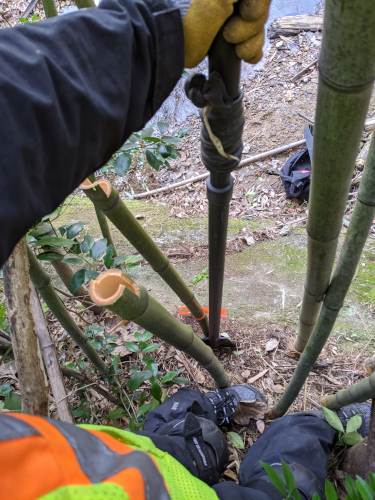
Steep anti-erosion wall, Madaké grove in Japan, 2020
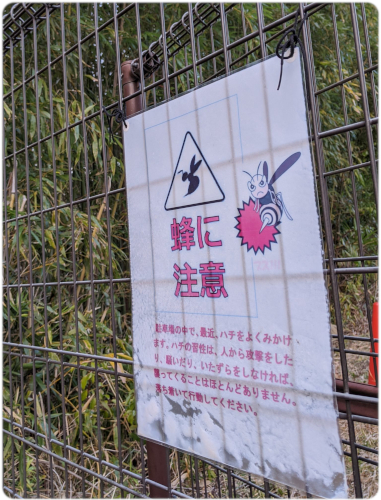
Deadly giant wasp warning sign outside of a Madaké grove in Nara Japan, 2020
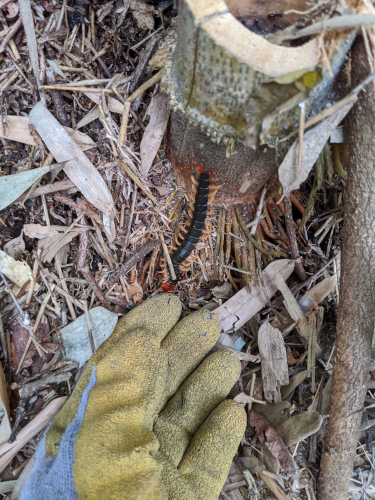
Venomous centipede that crawled onto my boot in a Madaké grove, Nara Japan, 2020
We harvest bamboo in winter primarily because potentially dangerous insects and other creatures have mostly, hopefully gone dormant. Not to mention wild boars are somewhat less active during the winter (also venomous snakes in other parts of the world such as North America). Of course, when harvesting Madaké all of the dangers of doing hard manual labor with sharp tools are present. Lastly, in winter the bamboo will tend to be more dormant as well with less water content making the drying process somewhat faster and less likely to cause cracking. Similarly, the mild winter sun provides for a more steady sun drying process that's also less likely to cause the bamboo to crack.
Fire curing bamboo for shakuhachi or Aburanuki
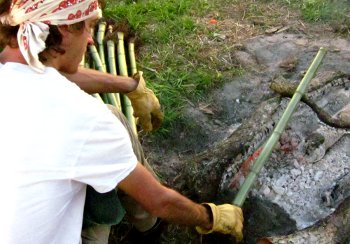
Me performing aburanuki, 2010
There's nothing like the smell of cooking green Madaké bamboo. After many long hours of harvesting, transporting, and cleaning, the time finally comes for the next magical process in shakuhachi construction called aburanuki. Aburanuki is the act of sweating bamboo over a heat-source which drives out moisture and cooks the juices of the bamboo, making them more viscous like glue. This in turn makes the bamboo dry faster and makes it somewhat stronger or less likely to crack.
After performing aburanuki the bamboo is placed in the full sun to dry for a month or more, with each piece being rotated to receive even sunlight. After sun drying, the bamboo is placed indoors to further dry or “cure” for a year, but often three years or more (if worked too soon the bamboo will gum-up tools among other issues).
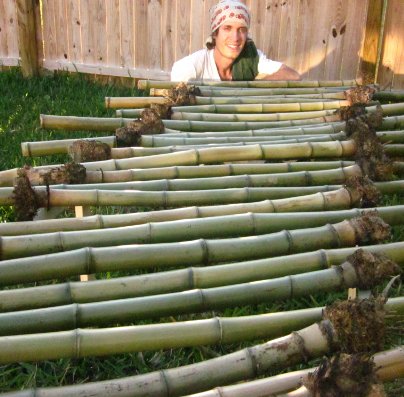
Me with my harvest of Japanese Madaké bamboo drying in the sun, 2010
➤ Visit my shakuhachi for sale page to see what's available.
Below you'll find additional useful reading:
- The Shakuhachi
All about the essence of the shakuhachi or what sets it apart from other flutes. - Types of shakuhachi; Jinashi and Jimori vs. Jiari/Jinuri and 'cast-bores'
- Shakuhachi buying guide - how to buy shakuhachi
Including insight into shakuhachi prices or value. - Shakuhachi bore sizes: wide, medium, and narrow - a ratio of volume to length
- Traditional tapered shakuhachi bores vs. cylindrical bore flutes, such as pvc.
- No 'Best' Shakuhachi
An essay about how there's no such thing as the 'best' shakuhachi. - The Shaku and Shakuhachi
All about the shaku lengths; 1.8, 1.9, 2.0 and so on.